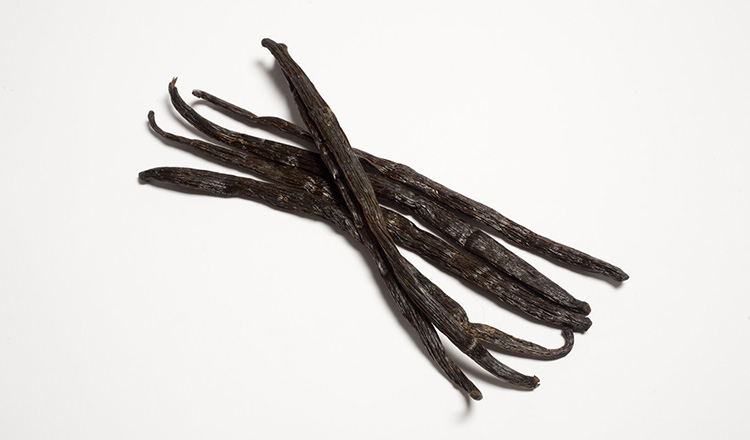
When you’re making a simple dessert, like vanilla ice cream or crème brûlée, you have very few ingredients to distract from the flavors of the raw ingredients. For that reason, the best outcomes will come from the best ingredients.
We know a lot these days about sourcing high quality milk and eggs (happy animals make great ingredients!), but what about the vanilla that is often the only flavoring in our favorite desserts?
Though vanilla comes in many forms—at dramatically different price points—the ideal form, for the most pronounced and pure flavor, is in their natural state, in other words, as pods. Though commonly referred to as vanilla “beans,” because they do contain beans, they actually grow as the pod from a type of orchid.
They are originally from the Gulf Coast of Mexico, but are also grown in Tahiti, Madagascar, and Indonesia, where the quality can be outstanding. Other, lesser known, vanilla-growing countries are India, Uganda, Papua New Guinea, and even the United States (Florida). There are close to 150 varieties of vanilla pods that grow in tropical climates around the world, but Bourbon and Tahitian are the most widely used.
Bourbon
When grown in Mexico, they are known as Mexican vanilla beans (pods), but if the same plant is grown in Madagascar or Indonesia, they are known as Bourbon vanilla beans (pods). Some Bourbon pods may develop over time what the French call givre, which is a frosting of natural vanillin crystals. This is an indication of very good quality. Do not confuse these crystals with mildew. Crystals are sparkling white, mildew is dull green.
Tahitian
The original plant is also from Mexico, yet it is considered its own species. The flavor of each variety is determined by species, but also by the soil, climate, and curing process. Plants of the same species that are planted 10 miles apart will have subtle flavor differences. Mexican Tahitian vanilla pods and Madagascar Tahitian vanilla pods have a significantly different flavor.
A good vanilla bean will be plump and have an oily skin and an intense aroma. Low-quality beans will be dry to the point of being brittle, and their aroma will be weak.
In order to obtain the most flavor from a vanilla pod, it is recommended to split the vanilla pod in half with a paring knife and scrape the beans off with the back side of the knife. Beans and pod should be added to the liquid from the beginning of the cooking or heating process, when it is still cold. Heat is the best way to extract the most avor from the vanilla pod. The type of vanilla used in any given recipe is entirely up to your personal preference.
To store vanilla pods, keep them in an airtight container, such as a jar or a tea tin. If exposed to the air for long periods of time, much of their aroma will dissipate.
Of course, vanilla beans are not only very expensive, but also difficult to source for the average home baker. Often, the vanilla beans that are found at grocery stores are dry and brittle, and hardly worth the splurge. If cost and convenience are a consideration, reserve your beans for when the vanilla will really shine, like in vanilla ice cream, custards, or frostings.
Vanilla extract is made by soaking vanilla beans in an alcohol solution. The solids are discarded and the remaining solution is vanilla-infused. Many, if not most, of the vanillas sold in the US are imitation vanilla flavoring, so look for higher quality extracts that are labelled as pure vanilla extract. If it’s very affordable, it’s sadly likely imitation flavoring.
Vanilla bean paste is a mixture of the seeds from within the vanilla pod, vanilla extract, sugar, and other thickeners. It packs a little more punch than vanilla extract, and because it contains the seeds, your finished product will have the little specks that we associate with high-quality vanilla baked goods. It’s a good alternative to fresh beans, but isn’t worth the splurge for ingredients where the vanilla is a background flavor, like in cookies or pies.
Vanilla powder is made by grinding whole beans into a powder. It is more common in professional bakeshops for dry uses, like in a coating mixture for donuts. It’s not quite as flavorful as other products, however, and will rarely be your go-to for everyday baking.
A few more tips for using vanilla:
- This isn’t a hard and fast rule, but rather a good guide for recipe substitutions: 1 tbsp vanilla extract = 1 tbsp vanilla paste = 1 vanilla bean
- Don’t discard used vanilla beans! Give the bean a rinse and leave it out to air dry for a day or so. Keep a jar of granulated sugar that you can submerge your used and dried beans in. After some time, the sugar will take on the vanilla essence and can be used in coffee, scones, ice creams, or anything else.
